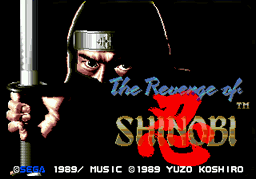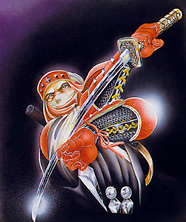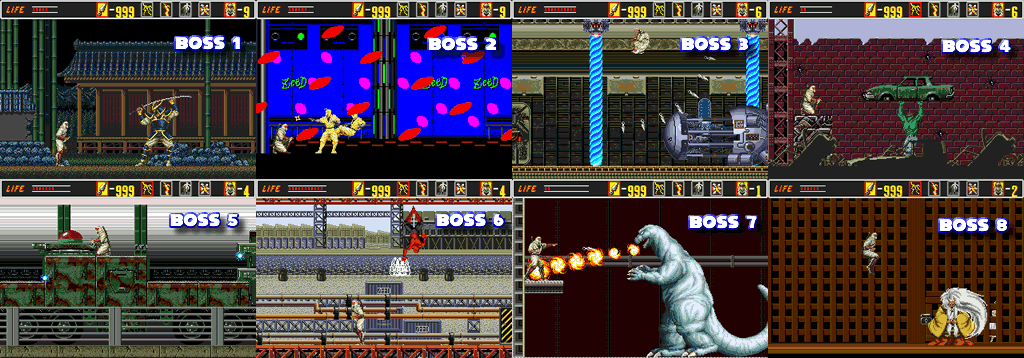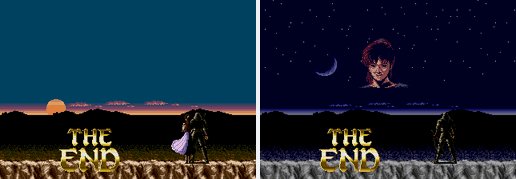You just received a shiny new Genesis for your birthday/Christmas/good grades, and you knew there was something special in that box, waiting to blow you away. After years of your NES and Master System, it seems like the next  generation (did they even use that term in 1989?) was finally here. Technically, it wasn’t, as NEC’s Turbo Grafx-16 had been kicking around for almost a year by the time the Genesis touched down, but NEC was a relatively unknown game-maker in the U.S., and Sega’s reputation for creating unparalleled arcade experiences was well known to video gamers. To a lesser extent, the Master System had also been screaming at the top of its lungs for almost five years, only to be drowned out completely by Mario and his 8-bit money maker. Of all the companies at the time, Sega seemed to be in the best position to challenge Nintendo, and things were looking up now that it’s new console had arrived.
generation (did they even use that term in 1989?) was finally here. Technically, it wasn’t, as NEC’s Turbo Grafx-16 had been kicking around for almost a year by the time the Genesis touched down, but NEC was a relatively unknown game-maker in the U.S., and Sega’s reputation for creating unparalleled arcade experiences was well known to video gamers. To a lesser extent, the Master System had also been screaming at the top of its lungs for almost five years, only to be drowned out completely by Mario and his 8-bit money maker. Of all the companies at the time, Sega seemed to be in the best position to challenge Nintendo, and things were looking up now that it’s new console had arrived.
Gamers who got a Genesis quickly booted up Altered Beast, to see if the rumors and hype about the console were true. Could it really “bring the arcade experience home”? Was it truly capable of mimicking those huge and expensive machines that swallowed lunch money with unflinching consistency? Was this the machine that would finally bring substance to the tem “arcade perfect?”
Well, no… The Genesis came darn close, but it wasn’t arcade perfect by any means. The thing was that virtually no one really noticed (or cared) back then. The sheer jump in graphics quality was enough in the minds of most to convince them that they’d be getting plenty of bang for their buck. Even so, many within the industry were quick to point out that man cannot live on ports alone, and that the Genesis would have to cough up some original properties to make its $189 price tag worthwhile. Moreover, as good as Golden Axe, Forgotten Worlds, and Altered Beast were, they needed to be complimented by some genuine exclusives. The ball was pitched to Sega to see if it could offer something that would fill this niche, something to make kids say “I need a Genesis.”
… and Sega hit it right out of the park with The Revenge of Shinobi.
Revenge is Best Served with a $49.99 Price Tag
What do you do when your bread and butter is comprised mostly of quality arcade ports, but you need an original killer app to pimp your new hardware? Easy, you create an original installment of one of your most popular arcade games. Such was the case of The Revenge of Shinobi, which dragged Joe Musashi out of retirement, shurikens and all, and made him the star of Sega’s new 16-bit stage. Competing almost exclusively in the action/platformer genre with the fun-but-all-too-brief Alex Kidd in the Enchanted Castle, a back-to-basics sequel in the Master System’s most prolific franchise, Revenge set about establishing the bar for the genre on the Genesis, and it is widely remembered as the game that virtually everyone with the console owned (along with Golden Axe, to be fair. Hey, those arcade ports rocked too!).

After only playing the first level, the differences between Shinobi and its sequel were readily apparent. Whereas the original had you slinging ninja stars and rescuing children, Revenge featured a very Storm Shadow-like Musashi (dig those crazy knee pads!) out to avenge the destruction of his clan and rescue his beloved Naoko from the clutches of the reborn and vengeful Neo Zeed crime organization. With katana and ninjitsu magic in tow, Musashi set off on an adventure that spanned eight segmented levels and in turn was launched into Genesis legend.
You have to understand, it was a great thing to get an original installment of a hit arcade franchise, especially one that expanded on everything that made the original so great to begin with. Be it Joe’s multiple ninja magic (which could now be chosen for use by the player at any time during a level), or the incredibly strong POW that also shielded him from incoming enemy fire, Revenge upped the ante in several areas. Most obvious were the visuals, which featured everything from lush forest settings to city streets and even the inside of a cargo plane. Sega must have smoked some great stuff at the time (whatever was left over from Nolan Bushnell’s Atari, perhaps?), because the developers were inspired to create some odd but very fun stages. C’mon, just tell me you didn’t enjoy slashing nuns on a highway? There was great variety to the environments, and each featured specific platforming challenges that thoroughly tested that newly-acquired double jump.
Click to see all the bosses!
That, to me, is what still makes The Revenge of Shinobi so much fun to play today. The graphics are still beautiful, especially for a launch-era title, but the level design holds as much challenge and diversity today as it did in 1989. Those darn airplane doors that would suck you out and kill you instantly, falling off a conveyor belt in the factory and having to ascend to the top from scratch, and most of all, that brain-cracking maze at the end – all of them are still challenging and fulfilling. I will admit that 1993’s Shinobi III: Return of the Ninja Master eclipses Revenge, but it took four long years to do so (Shadow Dancer is fun, but it’s no Shinobi III). At the time of its release, this first sequel was everything a killer app could hope to be, and it gave future action games on the Genesis something to shoot for. Not only that, it has since aged pretty darn well.
And those bosses! Who would have thought that one game would have you battle everything from Spider-Man to Godzilla? Yeah, I know that Tokyo’s favorite dino is a mere look-alike (so is Batman), but you have to admit that it’s far more than just a passing resemblance. I guess they were too close to their inspirations for Toho and DC Comics, as Sega made several revisions to the game over the next few years, changing all but Spidey himself (Sega had the license for the character at the time). I recommend that anyone wanting the definitive The Revenge of Shinobi experience track down a copy of version 1.00, which can be determined by the lack of a copyright notice at the start screen.
Another feather in Revenge’s cap is that it brought talented composer Yuzo Koshiro to the western spotlight. Already an industry veteran with Nihon Falcom, Koshiro’s name became a household word for American Genesis gamers after The Revenge of Shinobi. To this day, he’s still playing the score from his first Genesis outing to fans the world over, from Sweden to the U.S. , most recently with the Play! A Video Game Symphony tour. With a wide range of songs that ranged from techno to soft ballads (My Lover is a personal favorite), Koshiro became an instant Sega celebrity. He would go on to cement his Sega legacy only two years later with a little game called Streets of Rage.
Who Said Revenge Leaves You Empty?
 After all these years, there are many Genesis games that are still worth playing (I’ve over two hundred in my collection alone), but just as with any console, only a select few that can be considered mandatory purchases. In my mind, The Revenge of Shinobi is a title that should be on every self-respecting Genesis owner’s shelf. There’s a ton of gameplay in that tiny cartridge, and it’s still just as much fun as ever.
After all these years, there are many Genesis games that are still worth playing (I’ve over two hundred in my collection alone), but just as with any console, only a select few that can be considered mandatory purchases. In my mind, The Revenge of Shinobi is a title that should be on every self-respecting Genesis owner’s shelf. There’s a ton of gameplay in that tiny cartridge, and it’s still just as much fun as ever.
A word to the wise: don’t be fooled by the Game Boy Advance abomination that bears the same moniker; it has nothing but the name in common with Sega’s first 16-bit original classic. Whoever green lighted that train wreck deserves a katana right to where the Sun doesn’t shine. No, stick with the console version for all your ninja needs. Now if you’ll excuse me, I have to tackle that darn maze ONE more time before it drives me nuts. I want that good ending!



Recent Comments